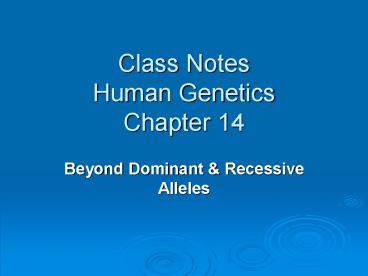Class Notes Human Genetics Chapter 14 - PowerPoint PPT Presentation
1 / 19
Title:
Class Notes Human Genetics Chapter 14
Description:
a case in which one allele is not completely dominant over another. ... Osteogenesis Imperfecta. Other Disorders. Achondroplasia autosomal, dwarfism (one form) ... – PowerPoint PPT presentation
Number of Views:358
Avg rating:3.0/5.0
Title: Class Notes Human Genetics Chapter 14
1
Class Notes Human GeneticsChapter 14
- Beyond Dominant Recessive Alleles
2
Incomplete dominance
- a case in which one allele is not completely
dominant over another. In incomplete dominance,
the heterozygous phenotype is somewhere in
between the 2 homozygous phenotypes.
3
Codominance
- a case in which both alleles contribute to the
phenotype of the organism. The phenotypic result
is similar to that of incomplete dominance.
4
Multiple Alleles
- many organisms have more than 2 alleles for a
given trait i.e. more than 2 alleles exist in
the population.
5
Polygenic Traits
- these are traits that are controlled by 2 or more
genes.
6
Human Heredity
- A picture of chromosomes arranged in this way is
known as a karyotype. - The karyotype to the left is from a typical human
body cell, which contains 46 chromosomes (23
pairs). - Two of these 46 chromosomes are known as sex
chromosomes, because they determine an
individuals sex. - Females have 2 copies of a large X chromosome and
males have one X and one small Y chromosome. - To distinguish them from sex chromosomes, the
remaining 44 chromosomes are known as autosomes.
7
Pedigree Chart
- A pedigree chart is a chart that shows the
relationships within a family. These are useful
to biologists when studying how a particular
trait is passed from one generation to the next
within a given family.
8
Pedigree Chart
9
Sex Linked Genes
- There is a special pattern of inheritance for
genes located on the X and Y (sex) chromosomes.
Genes located on these chromosomes are known as
sex-linked genes (x-linked) for short. Many
(most) sex-linked genes are found on the X
chromosome.
10
Sex Linked Genes
- More than 100 sex-linked genetic disorders have
now been mapped to the X chromosome. - The human Y chromosome is much smaller than the X
chromosome and appears to contain only a few
genes. - Males have just one X chromosome, thus ALL
SEX-LINKED ALLELES ARE EXPRESSED IN MALES, even
if they are recessive. - In order for a recessive trait to be expressed in
females, there must be 2 copies of the allele,
one on each of the two X chromosomes. - This means that the recessive phenotype of a
sex-linked genetic disorder tends to be much more
common in males than females. - Complete a punnett square below that shows the
passage of color blindness from parents to child
(text page 350).
11
Human Blood Types
- Human blood comes in a variety of genetically
determined blood groups. The best known are the
ABO blood groups and the Rh groups. - The Rh blood group is determined by a single gene
with 2 alleles ( and -) - the allele is dominant and the allele is
recessive. - A person can be Rh positive has alleles RhRh
or RhRh- - A person can be Rh negative has alleles Rh-Rh-
12
Human Blood Types
- With the ABO blood group, there are 3 alleles for
the gene (IA, IB, and i) - the alleles IA and IB are codominant both
alleles produce antigens that can be recognized
by the immune system on the surface of red blood
cells (an antigen is a substance that triggers an
immune system response) - individuals with alleles IA and IB produce both
antigens, making them blood type AB - the i allele is recessive
- individuals with alleles IAIA or IAi produce only
antigen A, making them blood type A - individuals with alleles IBIB or IBi produce only
antigen B, making them blood type B - individuals who are homozygous for the i allele
(ii) produce no antigen, and are said to have
blood type O.
13
(No Transcript)
14
The Human Genome Project
- The Human Genome Project is an attempt to
sequence all human DNA. In June 2000, scientists
announced that the DNA sequence of the human
genome was essentially complete. - DNA Fingerprinting is an analysis of sections of
DNA that have little or no known function, but
vary widely from one individual to another thus
making it an excellent way to identify
individuals - Gene therapy is the method of replacing and
absent or faulty gene by a normal, working gene.
15
Disorders in Humans
- Albinism autosomal, lack of pigment in skin,
hair, and eyes
16
Cystic Fibrosis
- Autosomal, excess mucus in lungs, digestive
tract, liver death at childhood unless treated
17
Tay-sachs disease
- Autosomal, lipid accumulation in brain cells
mental deficiency blindness death in early
childhood
18
Osteogenesis Imperfecta
19
Other Disorders
- Achondroplasiaautosomal, dwarfism (one form)
- Huntington's Diseaseautosomal, mental
deterioration and uncontrollable movements
appears in middle age - Sickle Cell diseaseautosomal, sickle shaped red
blood cells damage to many tissues - Hemophilia--sex-linked, protein in blood
necessary for clotting is missing uncontrolled
bleeding from minor injuries leads to death
unless treated - Duchenne Muscular Dystrophy--sex-linked,
progressive weakening and loss of skeletal
muscle rarely live past early adulthood - Down Syndromechromosomal, individual born with
too many copies of a chromosome (failure to
separate during meisos) - mild to severe mental
retardation































